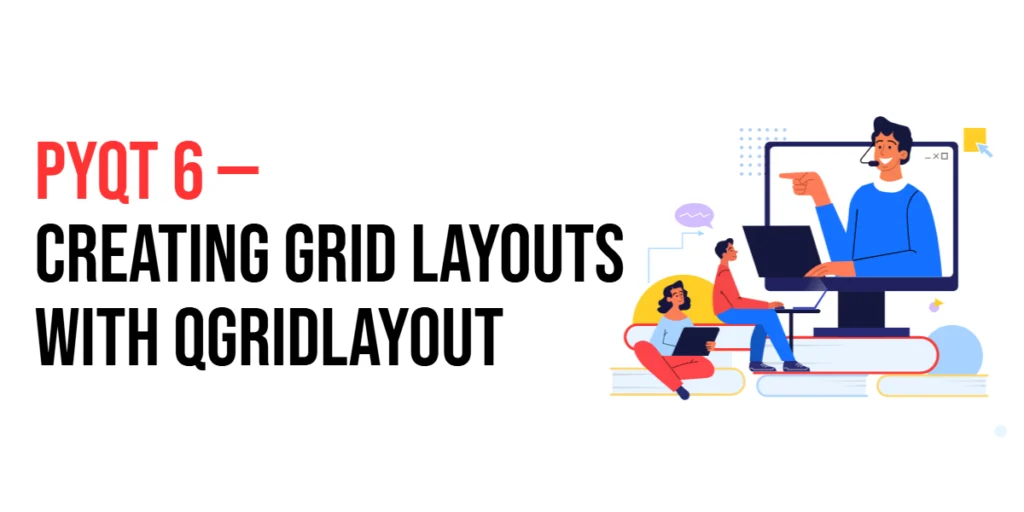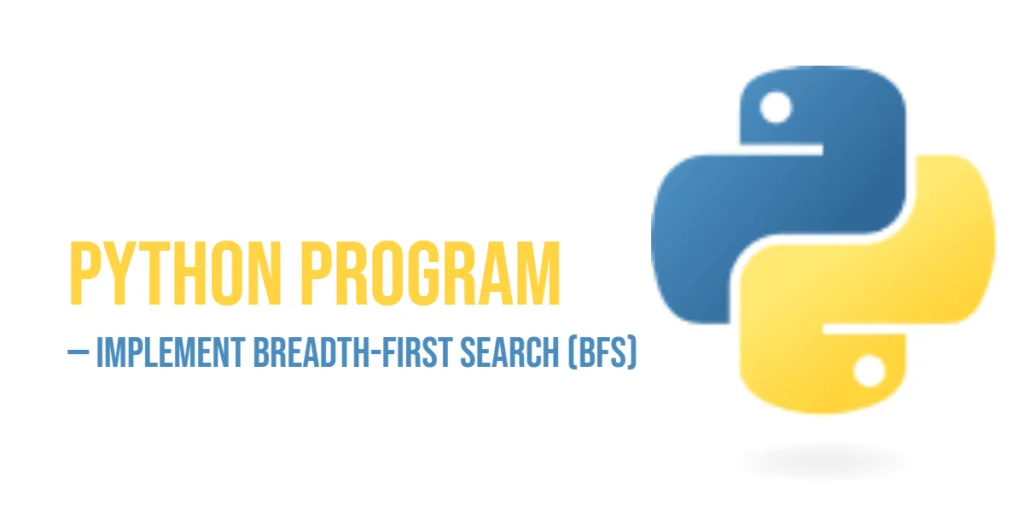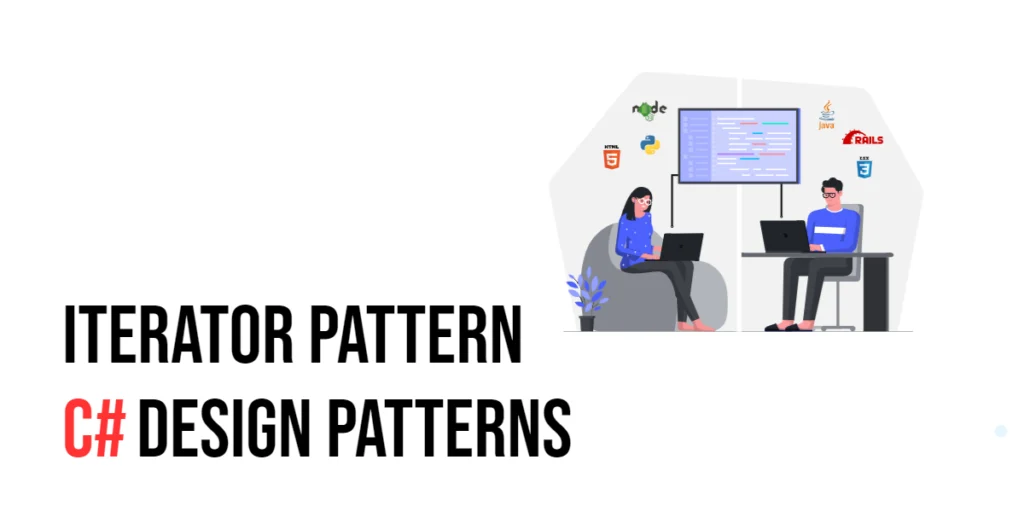Arranging widgets in a user interface is a fundamental aspect of GUI design. PyQt6 offers various layout managers to help developers organize widgets efficiently. One of the most flexible and powerful layout managers is QGridLayout, which arranges widgets in a grid-like structure. With QGridLayout, developers can create complex and organized user interfaces that adapt to different screen sizes and resolutions.

with hands-on learning.
get the skills and confidence to land your next move.
In this article, we will explore the features of QGridLayout, starting with setting up the development environment and creating a basic QGridLayout. We will then delve into adding widgets, customizing the layout’s appearance, handling resizing and alignment, and integrating QGridLayout with other layouts.
Setting Up the Development Environment
Before we dive into creating and customizing QGridLayout, we need to set up our development environment. This includes installing Python and PyQt6, and ensuring we have everything ready to start writing and running PyQt6 applications.
Installing Python and PyQt6
To get started, ensure you have Python installed on your computer. PyQt6 requires Python 3.6 or later. You can download the latest version of Python from the official Python website. Once Python is installed, open your command prompt or terminal and install PyQt6 using the pip package manager by running the following command:
pip install PyQt6This command will download and install PyQt6 along with all its dependencies.
Setting Up a Development Environment
To write and run your PyQt6 code, you can use any text editor or Integrated Development Environment (IDE). Some popular choices include PyCharm, a powerful IDE for Python with support for PyQt6; VS Code, a lightweight and versatile code editor with Python extensions; and Sublime Text, a simple yet efficient text editor. Choose the one that you’re most comfortable with.
Writing a Simple PyQt6 Application
To ensure everything is set up correctly, let’s write a simple PyQt6 application that creates a window with a QGridLayout.
- Create a New Python File: Open your IDE or text editor and create a new Python file named
simple_gridlayout.py. - Write the Code: Copy and paste the following code into your
simple_gridlayout.pyfile:
import sys
from PyQt6.QtWidgets import QApplication, QWidget, QGridLayout, QLabel
# Create an instance of QApplication
app = QApplication(sys.argv)
# Create a QWidget instance (main window)
window = QWidget()
window.setWindowTitle('Simple QGridLayout Example')
window.setGeometry(100, 100, 400, 300)
# Create a QGridLayout instance
layout = QGridLayout()
# Create a QLabel instance
label = QLabel('Hello, World!')
# Add the QLabel to the QGridLayout at position (0, 0)
layout.addWidget(label, 0, 0)
# Set the layout for the main window
window.setLayout(layout)
# Show the main window
window.show()
# Run the application's event loop
sys.exit(app.exec())- Run the Script: Save your file and run it. You should see a window with a label displaying “Hello, World!”.
In the code above, we start by importing the necessary modules from PyQt6, including QApplication, QWidget, QGridLayout, and QLabel.
Next, we create an instance of the QApplication class, which is required for any PyQt6 application. This instance manages application-wide resources and settings.
We then create an instance of QWidget, which serves as the main window of the application. We set the title of the window using the setWindowTitle method and define the position and size of the window using the setGeometry method.
A QGridLayout instance is created, and a QLabel widget is added to the layout at position (0, 0) using the addWidget method.
The layout is set for the main window using the setLayout method. Finally, we display the main window using the show method and start the application’s event loop with sys.exit(app.exec()). This event loop waits for user interactions and handles them accordingly, keeping the application running until the user closes the window.
By following these steps, you have successfully set up your development environment and created a simple PyQt6 application with a basic QGridLayout. In the next sections, we’ll explore how to add more widgets to QGridLayout and customize its appearance.
Creating a Basic QGridLayout
The QGridLayout widget provides a flexible and efficient way to arrange widgets in a grid. In this section, we will create a basic QGridLayout and add it to a PyQt6 application.
Introduction to QGridLayout
QGridLayout is a layout manager that arranges widgets in a grid-like structure with rows and columns. It is a part of the PyQt6 module and provides several customization options to fit the application’s design.
Code Example: Creating a Basic QGridLayout
To create a basic QGridLayout, follow these steps:
- Create a New Python File: Open your IDE or text editor and create a new Python file named
basic_gridlayout.py. - Write the Code: Copy and paste the following code into your
basic_gridlayout.pyfile:
import sys
from PyQt6.QtWidgets import QApplication, QWidget, QGridLayout, QLabel, QPushButton
# Create an instance of QApplication
app = QApplication(sys.argv)
# Create a QWidget instance (main window)
window = QWidget()
window.setWindowTitle('Basic QGridLayout Example')
window.setGeometry(100, 100, 400, 300)
# Create a QGridLayout instance
layout = QGridLayout()
# Create widgets
label = QLabel('Hello, World!')
button = QPushButton('Click Me')
# Add the QLabel and QPushButton to the QGridLayout
layout.addWidget(label, 0, 0)
layout.addWidget(button, 0, 1)
# Set the layout for the main window
window.setLayout(layout)
# Show the main window
window.show()
# Run the application's event loop
sys.exit(app.exec())- Run the Script: Save your file and run it. You should see a window with a label displaying “Hello, World!” and a button labeled “Click Me”.
We create a QGridLayout instance and add a QLabel widget and a QPushButton widget to the layout at positions (0, 0) and (0, 1), respectively, using the addWidget method.
By following these steps, you have created a basic QGridLayout in a PyQt6 application. In the next sections, we will explore how to add more widgets to QGridLayout and customize its appearance.
Adding Widgets to QGridLayout
QGridLayout allows you to add multiple widgets, creating a grid-like interface. In this section, we will explore how to add different types of widgets to QGridLayout.
Adding Different Types of Widgets
You can add various types of widgets to QGridLayout, such as labels, buttons, text fields, and images. This allows you to create rich and interactive user interfaces.
Code Examples: Adding and Configuring Widgets
To add and configure widgets in QGridLayout, follow these steps:
- Create a New Python File: Open your IDE or text editor and create a new Python file named
add_widgets_gridlayout.py. - Write the Code: Copy and paste the following code into your
add_widgets_gridlayout.pyfile:
import sys
from PyQt6.QtWidgets import QApplication, QWidget, QGridLayout, QLabel, QPushButton, QLineEdit, QComboBox
# Create an instance of QApplication
app = QApplication(sys.argv)
# Create a QWidget instance (main window)
window = QWidget()
window.setWindowTitle('Add Widgets to QGridLayout Example')
window.setGeometry(100, 100, 400, 300)
# Create a QGridLayout instance
layout = QGridLayout()
# Create widgets
label = QLabel('Enter your name:')
line_edit = QLineEdit()
button = QPushButton('Submit')
combo_box = QComboBox()
combo_box.addItems(['Option 1', 'Option 2', 'Option 3'])
# Add the widgets to the QGridLayout
layout.addWidget(label, 0, 0)
layout.addWidget(line_edit, 0, 1)
layout.addWidget(button, 1, 0, 1, 2) # Span button across 2 columns
layout.addWidget(combo_box, 2, 0, 1, 2) # Span combo box across 2 columns
# Set the layout for the main window
window.setLayout(layout)
# Show the main window
window.show()
# Run the application's event loop
sys.exit(app.exec())- Run the Script: Save your file and run it. You should see a window with a label, text field, button, and combo box arranged in a grid.
We create a QGridLayout instance and add various widgets, including a QLabel, QLineEdit, QPushButton, and QComboBox, to the layout at specific positions using the addWidget method. We also span the button and combo box across two columns.
By following these steps, you have added multiple widgets to QGridLayout in a PyQt6 application. In the next section, we will explore how to customize the appearance of QGridLayout.
Customizing QGridLayout Appearance
QGridLayout allows you to customize its appearance to match the design of your application. In this section, we will explore how to change the spacing and margins of QGridLayout.
Changing Spacing and Margins
You can customize the spacing between widgets and the margins around the layout using various methods provided by QGridLayout.
Code Examples: Customizing Layout Properties
To customize the appearance of QGridLayout, follow these steps:
- Create a New Python File: Open your IDE or text editor and create a new Python file named
custom_layout_gridlayout.py. - Write the Code: Copy and paste the following code into your
custom_layout_gridlayout.pyfile:
import sys
from PyQt6.QtWidgets import QApplication, QWidget, QGridLayout, QLabel, QPushButton
# Create an instance of QApplication
app = QApplication(sys.argv)
# Create a QWidget instance (main window)
window = QWidget()
window.setWindowTitle('Custom QGridLayout Example')
window.setGeometry(100, 100, 400, 300)
# Create a QGridLayout instance
layout = QGridLayout()
# Set spacing and margins
layout.setHorizontalSpacing(20)
layout.setVerticalSpacing(15)
layout.setContentsMargins(10, 10, 10, 10)
# Create widgets
label = QLabel('This is a label.')
button = QPushButton('This is a button.')
# Add the widgets to the QGridLayout
layout.addWidget(label, 0, 0)
layout.addWidget(button, 0, 1)
# Set the layout for the main window
window.setLayout(layout)
# Show the main window
window.show()
# Run the application's event loop
sys.exit(app.exec())- Run the Script: Save your file and run it. You should see a window with a label and button arranged in a grid with customized spacing and margins.
We create a QGridLayout instance and customize its appearance by setting the horizontal and vertical spacing between widgets using the setHorizontalSpacing and setVerticalSpacing methods, and the margins around the layout using the setContentsMargins method.
We create a QLabel widget and a QPushButton widget, and add them to the layout at specific positions using the addWidget method.
By following these steps, you have customized the appearance of QGridLayout in a PyQt6 application. In the next section, we will explore how to handle widget resizing and alignment in QGridLayout.
Handling Widget Resizing and Alignment
QGridLayout allows you to manage the resizing behavior and alignment of widgets within the layout. In this section, we will explore how to handle widget resizing and alignment in QGridLayout.
Managing Resizing Behavior
You can manage the resizing behavior of widgets in QGridLayout by using stretch factors and expanding spaces.
Code Examples: Aligning and Resizing Widgets
To handle widget resizing and alignment in QGridLayout, follow these steps:
- Create a New Python File: Open your IDE or text editor and create a new Python file named
resize_align_gridlayout.py. - Write the Code: Copy and paste the following code into your
resize_align_gridlayout.pyfile:
import sys
from PyQt6.QtCore import Qt
from PyQt6.QtWidgets import QApplication, QWidget, QGridLayout, QLabel, QPushButton, QSizePolicy
# Create an instance of QApplication
app = QApplication(sys.argv)
# Create a QWidget instance (main window)
window = QWidget()
window.setWindowTitle('Resize and Align QGridLayout Example')
window.setGeometry(100, 100, 400, 300)
# Create a QGridLayout instance
layout = QGridLayout()
# Create widgets
label_top = QLabel('Top Aligned Label')
label_bottom = QLabel('Bottom Aligned Label')
button_expand = QPushButton('Expanding Button')
# Set size policy for the expanding button
button_expand.setSizePolicy(QSizePolicy.Policy.Expanding, QSizePolicy.Policy.Expanding)
# Add widgets to the layout with alignment and span
layout.addWidget(label_top, 0, 0, alignment=Qt.AlignmentFlag.AlignTop)
layout.addWidget(button_expand, 1, 0)
layout.addWidget(label_bottom, 2, 0, alignment=Qt.AlignmentFlag.AlignBottom)
# Set the layout for the main window
window.setLayout(layout)
# Show the main window
window.show()
# Run the application's event loop
sys.exit(app.exec())- Run the Script: Save your file and run it. You should see a window with a top-aligned label, an expanding button, and a bottom-aligned label.
We create a QGridLayout instance and add various widgets, including QLabel and QPushButton, to the layout at specific positions using the addWidget method. We set the size policy for the button to make it expandable using the setSizePolicy method.
By following these steps, you have managed widget resizing and alignment in QGridLayout in a PyQt6 application. In the next section, we will explore how to integrate QGridLayout with other layouts to create complex interfaces.
Integrating QGridLayout with Other Layouts
QGridLayout can be integrated with other layouts, such as QVBoxLayout and QHBoxLayout, to create more complex and flexible user interfaces. In this section, we will explore how to combine QGridLayout with other layouts.
Combining QGridLayout with QVBoxLayout and QHBoxLayout
You can combine QGridLayout with other layout managers to create nested layouts and more complex interfaces.
Code Examples: Creating Complex Layouts
To create complex layouts using QGridLayout and other layout managers, follow these steps:
- Create a New Python File: Open your IDE or text editor and create a new Python file named
complex_layouts_gridlayout.py. - Write the Code: Copy and paste the following code into your
complex_layouts_gridlayout.pyfile:
import sys
from PyQt6.QtWidgets import QApplication, QWidget, QVBoxLayout, QHBoxLayout, QGridLayout, QLabel, QPushButton
# Create an instance of QApplication
app = QApplication(sys.argv)
# Create a QWidget instance (main window)
window = QWidget()
window.setWindowTitle('Complex Layouts with QGridLayout Example')
window.setGeometry(100, 100, 400, 300)
# Create a main QVBoxLayout instance
main_layout = QVBoxLayout()
# Create a QHBoxLayout instance
hbox_layout = QHBoxLayout()
# Create a QGridLayout instance
grid_layout = QGridLayout()
# Create widgets
label_1 = QLabel('Label 1')
label_2 = QLabel('Label 2')
button_1 = QPushButton('Button 1')
button_2 = QPushButton('Button 2')
button_3 = QPushButton('Button 3')
button_4 = QPushButton('Button 4')
# Add widgets to the QHBoxLayout
hbox_layout.addWidget(label_1)
hbox_layout.addWidget(button_1)
# Add widgets to the QGridLayout
grid_layout.addWidget(label_2, 0, 0)
grid_layout.addWidget(button_2, 0, 1)
grid_layout.addWidget(button_3, 1, 0)
grid_layout.addWidget(button_4, 1, 1)
# Add the QHBoxLayout and QGridLayout to the main QVBoxLayout
main_layout.addLayout(hbox_layout)
main_layout.addLayout(grid_layout)
# Set the layout for the main window
window.setLayout(main_layout)
# Show the main window
window.show()
# Run the application's event loop
sys.exit(app.exec())- Run the Script: Save your file and run it. You should see a window with a combination of horizontal and grid layouts nested within a vertical layout.
By following these steps, you have created complex layouts by integrating QGridLayout with other layout managers in a PyQt6 application. In the next section, we will explore advanced features of QGridLayout.
Advanced QGridLayout Features
QGridLayout offers various advanced features that can enhance its functionality and user experience. In this section, we will explore how to use row and column stretch factors in QGridLayout.
Using Row and Column Stretch Factors
You can use row and column stretch factors to control the distribution of space among widgets in QGridLayout.
Code Examples: Implementing Advanced Features
To implement advanced features in QGridLayout, follow these steps:
- Create a New Python File: Open your IDE or text editor and create a new Python file named
advanced_features_gridlayout.py. - Write the Code: Copy and paste the following code into your
advanced_features_gridlayout.pyfile:
import sys
from PyQt6.QtWidgets import QApplication, QWidget, QGridLayout, QLabel, QPushButton
# Create an instance of QApplication
app = QApplication(sys.argv)
# Create a QWidget instance (main window)
window = QWidget()
window.setWindowTitle('Advanced Features with QGridLayout Example')
window.setGeometry(100, 100, 400, 300)
# Create a QGridLayout instance
layout = QGridLayout()
# Create widgets
label_1 = QLabel('Label 1')
label_2 = QLabel('Label 2')
button_1 = QPushButton('Button 1')
button_2 = QPushButton('Button 2')
# Add widgets to the layout with row and column stretch factors
layout.addWidget(label_1, 0, 0)
layout.addWidget(button_1, 0, 1)
layout.setColumnStretch(1, 1) # Stretch the second column
layout.addWidget(label_2, 1, 0)
layout.addWidget(button_2, 1, 1)
layout.setRowStretch(1, 1) # Stretch the second row
# Set the layout for the main window
window.setLayout(layout)
# Show the main window
window.show()
# Run the application's event loop
sys.exit(app.exec())- Run the Script: Save your file and run it. You should see a window with labels and buttons arranged with stretched columns and rows.
We create a QGridLayout instance and add various widgets, including QLabel and QPushButton, to the layout at specific positions using the addWidget method. We use the setColumnStretch and setRowStretch methods to stretch specific columns and rows.
By following these steps, you have implemented advanced features in QGridLayout in a PyQt6 application.
Conclusion
In this article, we explored the versatile and powerful QGridLayout widget in PyQt6 for arranging widgets in a grid. We started with an introduction to QGridLayout and its importance in GUI applications. We then walked through setting up your development environment, creating a basic QGridLayout, and adding widgets to it.
We demonstrated how to customize the appearance of QGridLayout, handle widget resizing and alignment, and integrate it with other layouts. Additionally, we covered implementing advanced features such as row and column stretch factors.
The examples and concepts covered in this article provide a solid foundation for working with QGridLayout in PyQt6. However, the possibilities are endless. I encourage you to experiment further and explore more advanced features and customizations. Try combining QGridLayout with other PyQt6 widgets and layout managers to create rich, interactive user interfaces. Don’t hesitate to experiment with different styles, signals, and slots to make your applications unique and engaging.
Additional Resources for Learning PyQt6 and QGridLayout
To continue your journey with PyQt6 and QGridLayout, here are some additional resources that will help you expand your knowledge and skills:
- PyQt6 Documentation: The official documentation is a comprehensive resource for understanding the capabilities and usage of PyQt6. PyQt6 Documentation
- Online Tutorials and Courses: Websites like Real Python, Udemy, and Coursera offer detailed tutorials and courses on PyQt6, catering to different levels of expertise.
- Books: Books such as “Rapid GUI Programming with Python and Qt” by Mark Summerfield provide in-depth insights and practical examples.
- Community and Forums: Join online communities and forums like Stack Overflow, Reddit, and the PyQt mailing list to connect with other PyQt developers, ask questions, and share knowledge.
- Sample Projects and Open Source: Explore sample projects and open-source PyQt6 applications on GitHub to see how others have implemented various features and functionalities.
By leveraging these resources and continuously practicing, you’ll become proficient in PyQt6 and be well on your way to developing impressive and functional desktop applications.







